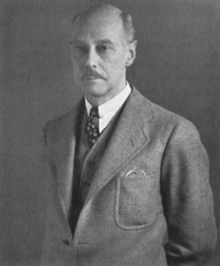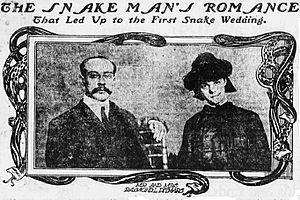Raymond Ditmars facts for kids
Quick facts for kids
Raymond Ditmars
|
|
|---|---|

Ditmars
|
|
| Born |
Raymond L. Ditmars
June 22, 1876 Newark, New Jersey, U.S.
|
| Died | May 12, 1942 (aged 65) New York, New York, U.S.
|
| Nationality | American |
| Occupation | Zoologist |
Raymond Lee Ditmars (born June 22, 1876 – died May 12, 1942) was an American scientist who studied reptiles and amphibians. He was also a writer, a public speaker, and a pioneer in making nature films.
Contents
Raymond Ditmars' Early Life and Work
Raymond Ditmars loved all animals, especially reptiles. He got his first snakes when he was just 12 years old. His parents even let him keep many different kinds of snakes, including venomous ones, in their home's attic! Raymond left school at 16. Even without a formal degree, he learned a lot about zoology by studying snakes and other animals. He observed them both in the wild and in captivity. Throughout his life, he spent his vacations looking for new animal specimens. Because of his great interest and knowledge, he became known as a top expert on reptiles and amphibians in the country.
In 1893, Ditmars started working at the American Museum of Natural History. He was an assistant in the Department of Entomology, which studies insects. He got this job mainly because he was a talented artist. Four years later, he left this job for a better-paying one as a stenographer. In July 1898, he briefly worked as a court reporter for New York Times.
Joining the Bronx Zoo Team
One of Raymond's first news stories led him to discover the new New York Zoological Society. This group, now called the Wildlife Conservation Society, was building what would become the famous Bronx Zoo. On July 17, 1899, just four months before the zoo opened, Ditmars got a job there. He became an assistant curator in charge of the reptiles. He was only 23 years old at the time. He would spend the rest of his career working at the zoo.
Raymond brought his own collection of 45 reptiles to the zoo. These animals, representing 15 different species, became the first residents of the reptile house. The reptile house was an instant hit with visitors!
A few years later, he started working on his first big book, The Reptile Book. At the same time, he taught himself how to take still photos and make motion pictures. He drew almost all the pictures for this book and his many books that followed.
Pioneering Nature Films
In 1914, Raymond Ditmars created and released The Living Book of Nature. This was his first motion picture, and it was very popular. Many other films followed. He was a pioneer, using the newest film techniques available. These included stop-motion animation, timelapse photography, and macro photography (taking close-up pictures of small things). By the mid-1920s, he was even making sound films.
Helping with Antivenom and Expeditions
In the late 1920s, Ditmars helped set up antivenom centers. These centers provide medicine to treat snake bites. They were created in the United States and Honduras. Soon after, he began a series of trips to Central and South America. He was looking for tropical animals for the zoo. His main goal was to find a bushmaster, which is the world's largest type of viper. He successfully brought one back from the island of Trinidad in 1934. The year before, he also famously collected and showed the first living vampire bats at the zoo.
Expanding His Role at the Zoo
Raymond Ditmars was also very good at caring for animals. He taught himself how to do this. Soon after starting at the Bronx Zoo, he was unofficially given responsibility for mammals as well as reptiles. He officially became the Curator of Mammals in 1926. This happened after the zoo's first Director, William Hornaday, retired. In 1940, just two years before he passed away, Ditmars also took charge of insects. This was after a very successful insect exhibit at the 1939–40 World's Fair.
Raymond Ditmars was good at getting attention for himself and the zoo. He had good relationships with reporters in New York. This meant that he and the zoo were often in the newspapers. Thanks to Ditmars's hard work and excitement, the Bronx Zoo became a world-famous place.
Books by Raymond Ditmars
Ditmars wrote several books about zoology, his own life, and his travels. The Reptile Book, which we talked about earlier, came out in 1907 and was a huge success. It was republished and made bigger several times.
With books like Reptiles of the World (1910), Snakes of the World (1931), Reptiles of North America (1936), and Field Book of North American Snakes (1939), he helped many people learn about reptiles. Many reptile scientists who grew up after World War II fell in love with reptiles partly because they read Ditmars's books. Often, his books were the only ones about reptiles available in school and town libraries back then.
His other books, which were more about his own life, were also popular. These included:
- Strange Animals I Have Known (1931)
- Thrills of a Naturalist's Quest (1932)
- Confessions of a Scientist (1934)
- Snakehunters' Holiday (1935 – written with William Bridges)
- The Making of a Scientist (1937)
Raymond Ditmars' Legacy
Raymond Ditmars is remembered in the scientific name of a type of lizard, Phrynosoma ditmarsi. This means the lizard was named in his honor.
Films Directed by Raymond Ditmars
Ditmars was a pioneer in directing and producing many silent nature documentaries. Here are some examples:
- Life in Our Ponds (1912, Pathé Frères)
- Hidden Life in Sea Weed (1913, Pathé Frères)
- The Snowy Egret and Its Extermination (1913, Pathé Frères)
- The Fish with a Storage Battery in Its Brain (1913)
- The Deadliest of Nature's Celebrities (1914, Pathé Frères)
- Housekeeping at the Zoo (1910 - 1922, a film about how the New York Zoological Park was run)
- Insects That Mimic (1914, Pathé Frères (France))
- Amphibian Oddities (1916, Power Picture Plays)
- The Smaller Monkeys (1917)
- Evolution (1918, Educational Films Corporation of America)
- Biography of a Stag (1918, Educational Films, USA, a film from a zoo about how a stag's antlers grow)
- The Polar Bear (1919)
- The Four Seasons (1921, with Charles Urban?, Kineto Film Company of America, a poetic film about seasonal changes in nature)
- Like a Beaver (?)


